Written by Terry Smith
Our site is reader supported so when you click a link to Amazon we may earn an affiliate commission.
UK’s best axes and hatchets for splitting kindling wood reviewed
This article was last updated on April 23rd, 2022 at 5:21 am
Now we are into the coldest part of the year, our fire pits, chimineas, and indoor log fires should be seeing a lot of use, and that means a fair old bit of chopping wood and splitting logs for kindling – a manual log splitter or electric log splitter is an option but serious overkill and a lot of money upfront especially when the best axes and hatchets will split kindly faster and for a hundred times less money – especially if you know how to use one and keep it sharp.
Having a good quality axe or hatchet for splitting wood and creating kindling is so important if you want to get the job done quicker, safer, and with less effort. However, finding the best axes and hatches that are hidden amongst thousands of products isn’t that easy, especially when you consider not-so-truthful advertising and claims that aren’t lived up to so I’ve whittled down from 18 choices to just 6 – I’ve been very picky.
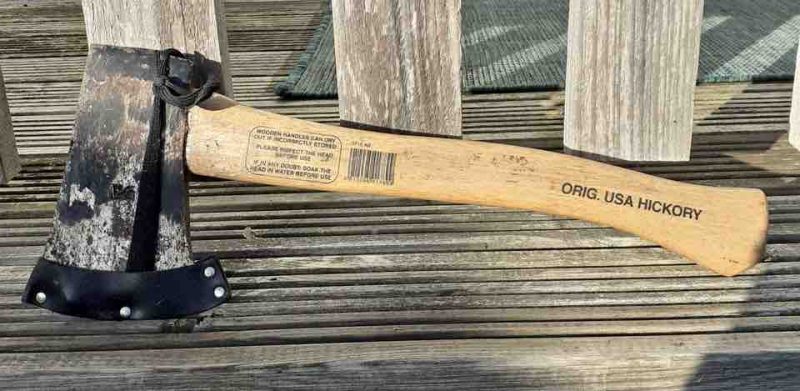
I know it looks easy on the telly, but ask anyone who has to split wood with an axe or hatchet on a regular basis, and they’ll tell you that it is tiring and tedious if you don’t approach it the right way, and with the right tools.
To make things easier on you, we’ve compiled a list of the best axes and hatchets for splitting kindling wood, and given each model a little test run to see how they held up under real life conditions. You can see what we thought of them in our reviews section further down the page, but here’s a shortlist of our axes and hatchets top picks-
Best axes and best hatchets – editors picks:
Best hatchet overall: Bulldog 1.5lbs hatchet – best hatchet for the money, and a good pick for a first kindling hatchet or for casual use.
Best axe for kindling: Fiskars XS X7 – best axe for kindling thanks to its excellent reliability and blade quality.
Best hatchet for backpackers: Lexivon V14 camping hatchet – It’s lightweight makes it ideal for being carried on long distances in your backpack.
Best steel hatchet: Draper steel hand axe – best steel hatchet and offers robustness and durability
Best hatchet for camping: Ruthe’s VPA/GS hatchet – it’s heavy head will help to cut through branches and logs while out in the wild.
Best axe for chopping small logs: Davaon Pro log splitting axe – It’s slightly longer handle and carbon steel head means it can easily split logs up to 20cm in diameter – a real cutting axe.
What to look for when buying the best axes and hatchets
Amazingly there are only a few things that really matter when buying an axe. Firstly the grip and handle material are super important. This is about prolonged use and safety. Then you want to consider the material the axe is made from. Basically, the higher the carbon in the steel the better as this will result is a heat treat on the blade which will last and last (it would be super if they kept the back of the axe untreated too – as this will absorb the vibration and stop your axe from breaking) – more on that later. The next thing is the balance and weight. This will define how well you chop wood – believe it or not, a better balanced axe can beat a heavier, poorly balanced hatchet! So let’s look closer:
A good grip
Axes and hatchets are sharp, and so it’s a good idea to keep them firmly in your hand and not randomly flying through the air. As both of the aforementioned tools are held in only one hand, the need for a good grip like the one found on the budget pick Bulldog or quality Fiskars becomes even more important for both safety and comfort.
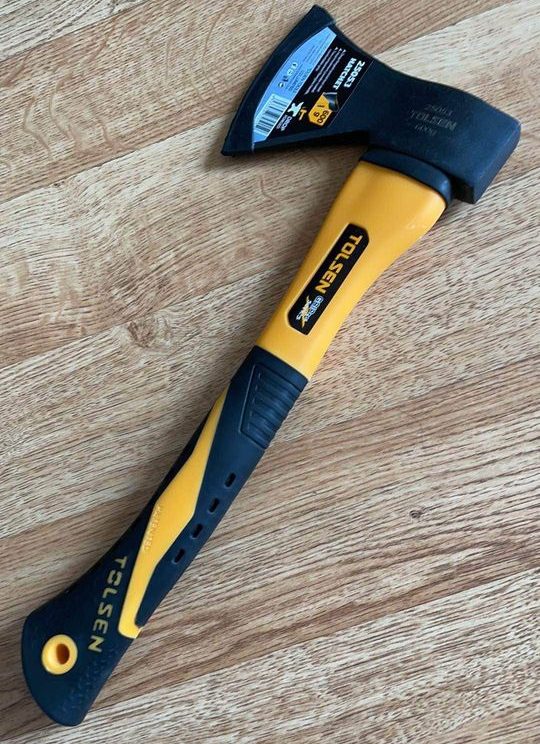
Avoid cheaply made products where the grip is made of poor material and not well bonded, or you’ll find it coming apart in very little time. Instead, look for a thick rubberised grip that will last a while, will help with the shock of impact, and also keep the tool firmly in the hand, even when your palms get a bit sweaty or it starts to rain.
Handle material
Your main choices when it comes to axe handle material are going to be wood (hickory on the Ruthe’s) and (fibre glass Bulldog or quality Fiskars). There are some axes and hatchets out there with metal handles, but they aren’t that common these days, and the ones that are usually have a rubber cover on the handle.
Wooden handles have been used on axes and hatchets for untold years, and with good reason. Good quality wood (Hickory) is very strong and durable without being too heavy, and it is a natural absorber of vibrations. You can run into issues with rot and other moisture or weather-based damage, but that’s easily avoided by putting the tool away properly after you’re done, and a little bit of varnish or stain for the handle:
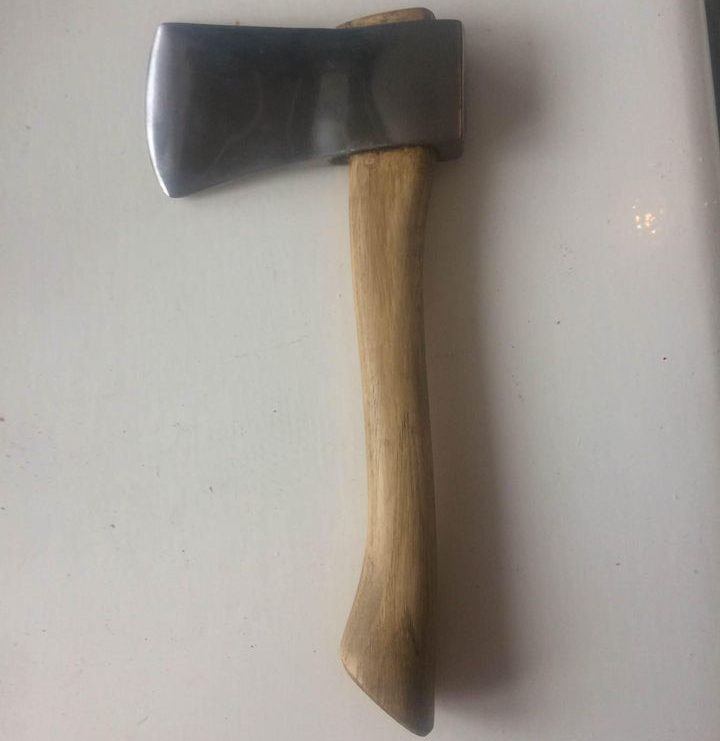
With fibreglass handles, you don’t have to worry about moisture or them being chewed on by insects. They are also very lightweight, even when compared to wooden handles. Fibreglass handles aren’t usually used for heavier axe blades though, due to imbalance issues, but for small hatchets they can be ideal.
The weight and balance
The chances are that you’ll be holding your axe or hatchet in one hand for extended lengths of time, so the weight of a given product should be something that interests you. For campers and backpackers, you ideally want a compact, fibre glass handled hatchet that is easy to carry around like the Lexivon.
If you want to chop some logs into kindling that are bigger than 20cm in diameter, then maybe a slightly heavier axe with a larger head and a nice, solid, wooden handle, like the Davaon would suit you more.
What is the difference between tinder, kindling, and firewood? What do you split with an axe?
People new to building fires or using wood as a fuel source for their wood burning stove might have heard these three terms, but might not know the difference, so we thought we’d quickly clarify.
Basically, both tinder and kindling can be firewood/fuel , and both are used to help get a fire started. The difference is that tinder refers to small pieces of material that catch fire very easily, and don’t necessarily have to be wood shavings. In fact, you can use anything that is readily available as tinder, such as dry leaves, tree bark, and pieces of old material like cotton – in the real world your tinder is firelighters.
Kindling is larger than tinder, and is used to keep the flames started by tinder burning until the logs on the fire take over as the main fuel source. Kindling is always wood, but can be in the form of twigs that are found if you are out in the wild. Most commonly though, the term kindling is used to describe smaller splinters of wood that have come from spit logs and are about 1-2 inches thick and maybe 1-2ft long.
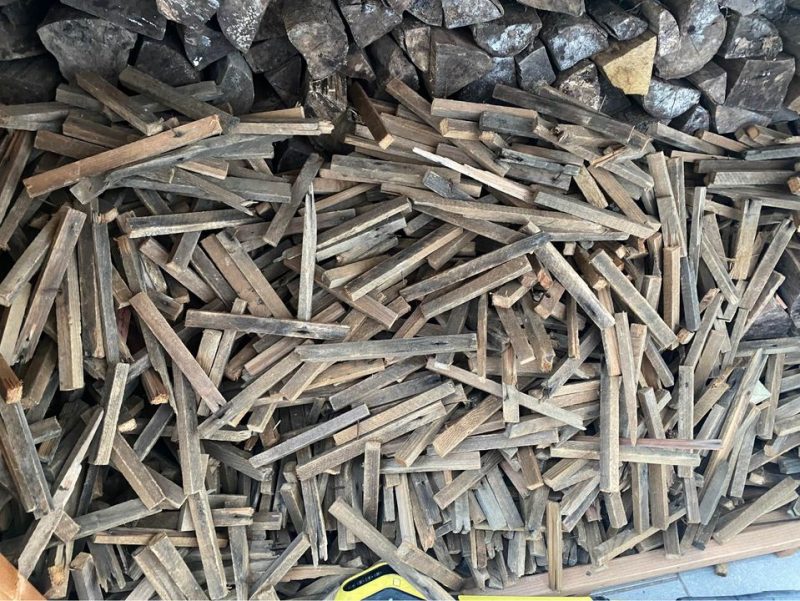
Are axes and hatchets the same thing?
Although similar, there is a distinction between axes and hatchets, and once again, it comes mainly down to size.
A standard axe has a much longer handle than a hatchet and is wielded two handed. They are great for cutting large logs and felling trees, but maybe not the best for splitting smaller ones into kindling because they are harder to control in smaller areas.
Hatches generally have a hammer on the non cutting side, making them a versatile tool:
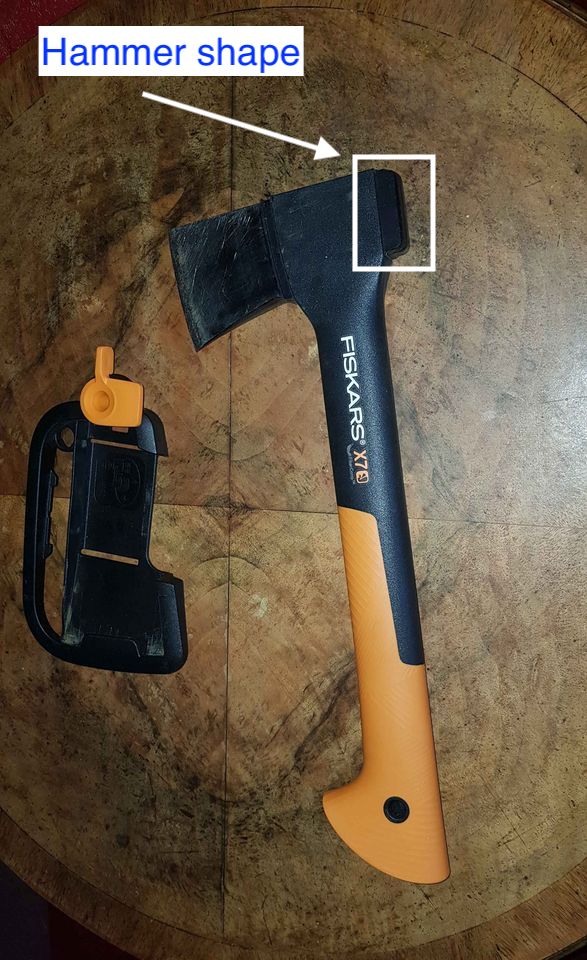
Hatchets are meant to be held in one hand and are much easier to control. This makes them ideal for splitting kindling from smaller logs. Their smaller size also means that you can easily throw them in your backpack and take them on camping trips with you.
Hand axes or kindling axes are somewhere in between a large wood axe and a hatchet, and are often confused with hatchets. You can tell the difference by the size and shape of the tool’s head, with hand axes having a larger head with a less drastic taper from front to rear. The handle too, is usually larger on a hand axe, and the shaft won’t curve towards the top like on many hatchets.
Both hand axes and hatchets are excellent tools for chopping logs into kindling, but hand axes are a little bit heftier and would make lighter work of larger logs than a hatchet. On the other hand, hatchets are smaller, lighter, and wouldn’t fatigue you as quickly if you have a large pile of small logs to split.
How to chop kindling with an axe or hatchet
You might be thinking “what a silly title! Just grab your log and hit it with the axe.” But chopping wood for kindling in the safest and most efficient manner is all about knowing what you’re doing. So, we decided to give a few pointers here-
- Make sure you know what you are trying to cut, and that you’re using the right tool for the job. The best logs for splitting into kindling are ones that are less dense and that have nice, straight grains running through them. Logs like these are easy to handle with a hatchet and should split fairly easily.
If the logs are a denser type of wood like oak, you might want to use an axe instead. It is possible to split denser wood with a hatchet but a lot depends on how skilled you are with the tool, how dry the log is, and other factors like swing power and accuracy. Here’s a good guide on that:
Avoid trying to split heavily knotted logs of any type with a hatchet or hand axe as they are just too hard, and you’re more likely to cause yourself an injury trying. Think of those old cartoons where Daffy duck or someone hits something hard with an axe or similar and ends up shaking in the air for a few seconds, and you get the idea. However, there are other tools you can use for knotted logs as we’ll explain later in this article.
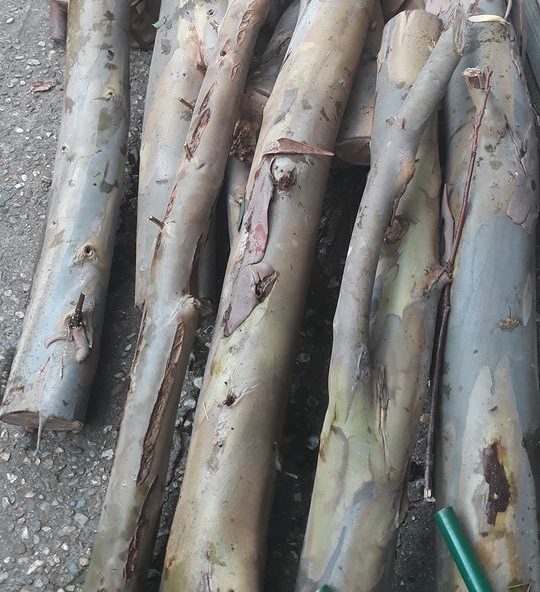
- Find a hard flat surface that you can sit the logs on as you split them, like a chopping block or the stump of an old tree as long as it is nice and flat, and solid of course. Never try to split wood for kindling on soft ground. The ground will absorb some of the impact, the log will not be stable, and it’s just a bad idea all together.
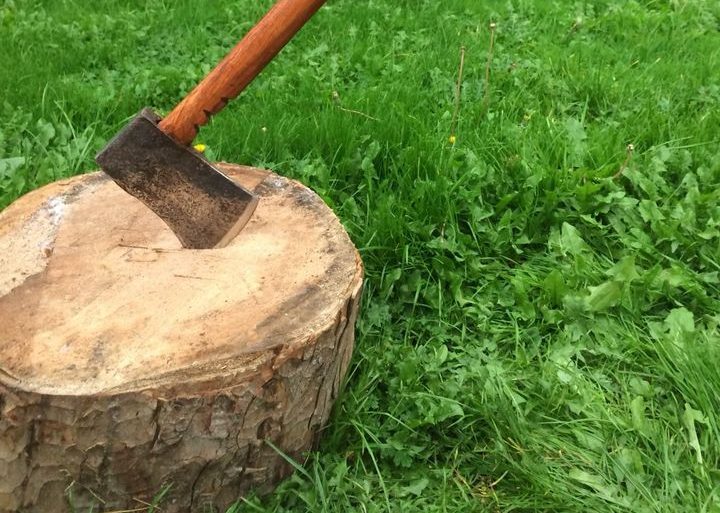
If there’s no chopping block, you can prop the log up on a strong piece of wood on the ground, then stand with your feet wide apart and the top of the log between them. You then just strike the top of the log with the axe or hatchet. This takes some practice to get right, but it works well in the absence of a cutting block.
Place the log that you’re going to split as far towards the rear of the chopping block (away from you) as possible while still keeping it stable enough to be hit without flying off. This is so that if you miss the log, and if you’re a beginner, that’s highly probable, the axe or hatchet will hit the chopping block and not your leg.
- Keep your hands away from the log that you are chopping into kindling. If you like playing on your smartphone, using the tv remote, or just generally enjoy having fingers, don’t hold onto the log with one hand and chop with the other. This guy shows you the perfect technique if it’s tough:
Practicing your accuracy with your hatchet or hand axe will help you split logs without knocking them off the chopping block, and if you’re really struggling to keep the target balanced and in place, you can use something like a good sized stick to hold and balance it. This will keep your digits out of harm’s way, and you’ll still be able to count to ten. Check out the video below for an example of this.
- A slower, but safer way to split smaller logs is to stick the blade of the axe into the log, and then lift them both before striking the chopping block with them. The wedge shape of the kindling axe’s head will then cause the log to split. This is also a good way to deal with things if your axe gets stuck in a log while trying to chop it.
Obviously, this would be much harder to do with larger logs, so I don’t recommend it, but this technique can come in handy if you’re not too confident with an axe or hatchet.
How to make kindling without an axe or hatchet – alternatives
Axes and hatchets aren’t your only options when it comes to splitting logs for kindling. Two of the least expensive, but still very useful, are log splitting wedges and log splitters.
Log splitting wedges are usually either shaped like a traditional triangular wedge, or there are the newer “grenade/bomb’ types. The latter are probably the easiest to get to grips with as a beginner due to the point being in the centre and therefore easier to dig into the log.
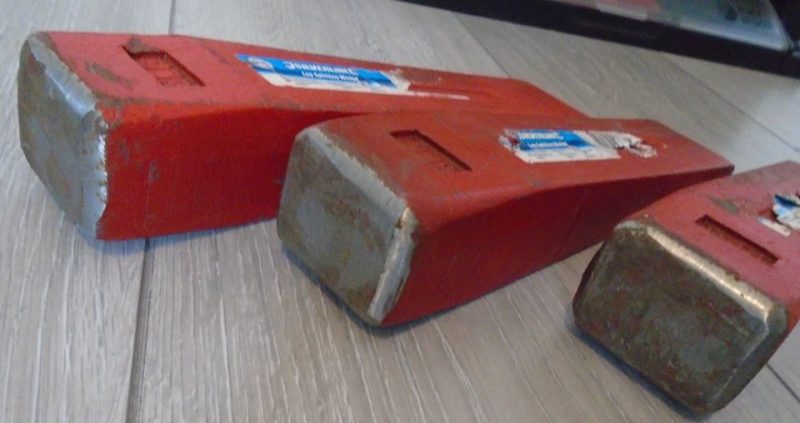
All you need to do once the point of the wedge is in the top of the log, is use a mallet to give it a few taps so it digs in further, then give it a few hard whacks until it finally splits the log. It’s low tech, takes a fair bit of physical effort, but can work well.
Alternatively, you can pay a bit more for a manual log splitter, and these come in two main types. The first is the guillotine type, known as a standing log splitter. You place the log into the splitter, and then drop the splitting blade down upon it. Because gravity is doing the work, this is a much less physically demanding way of splitting logs when compared to splitting wedges.
The other type of manual log splitter is the foot operated style. Again, they are very simple but effective tools for splitting small logs. All that you need to do is place the log in the splitter and then use your foot to work the hydraulic pump until the log splits into kindling.
Or how about an axe that opens your beer too – now that’s a cracker:
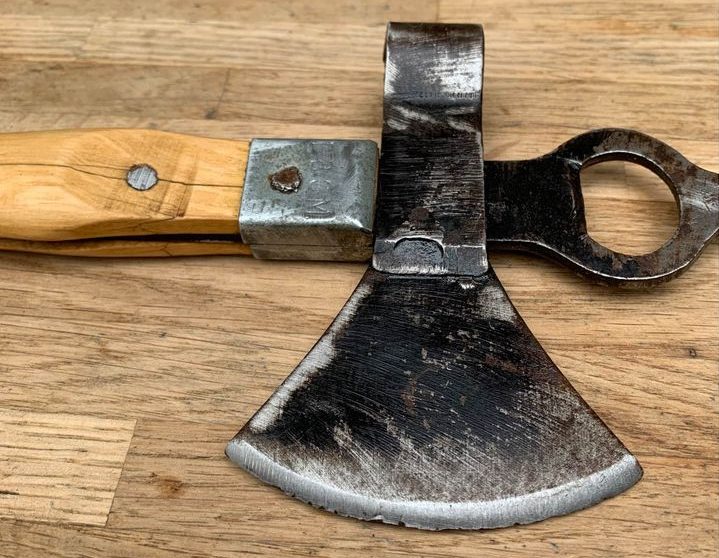
The following video shows how you can split good sized logs using a wedge, mallet, prying bar, and a bit of elbow grease, of course. –
Best axes and hatchets for splitting wood in the UK:
So, I think we’ve covered all the basics and important information regarding splitting kindling, so let’s have a closer look at the top axes and hatchets available for just that purpose.
1. Bulldog BHATCHETFG 1.5 lb Hatchet
I usually avoid cheaper tools like the plague due to being stung by the ‘buy cheap, buy twice’ thing one too many times, but every now and again, a budget product impresses me enough to recommend it to others and still remains my pick for the best axe in the UK overall as an average and a measure for all others. This hatchet from Bulldog is one of those products.
The first thing you notice about the Bulldog hatchet is that the 1.5lb weight of the forged steel head is extremely well balanced, and this gives a nice feeling of control over the tool, and more accuracy, when bringing it down on a log.
A secure grip, thanks to the ergonomic fibre glass handle, also helps with this almost instant familiarity, and this is why I think it would serve as a good first kindling axe for a lot of people, although people who will be using their hatchets on a daily basis might want to pay more for something that has a proven track record.
If you are going to go with the Bulldog 1.5lb hatchet, you are going to have to have the means of sharpening it, as it both arrives quite blunt, but once sharpened it works like a charm and you find the blade getting dull quickly.
Another thing I would recommend for potential buyers of this tool, is a proper sheath. The small plastic cover that comes with it is fairly useless, to be expected for the price I guess, so spend a few quid on a leather one like in the following twitter post and you’ll have yourself a decent little tool for a bargain price.
Pros
- Very low price tag
- Good first kindling hatchet for casual use
- Very well balanced and easy to swing accurately
- Sits in the hand firmly
Cons
- Comes quite blunt and will need sharpening, and you’ll need a better sheath.
2. Fiskars Chopping Axe XS X7
As I mentioned above, if you’re going to be using your axe or hatchet to split kindling on a daily basis, and for the foreseeable future, you should dip your hand a bit deeper in your pocket and get something that has proven to be reliable. AKA the Fiskars XS X7 chopping axe.
Yes, it costs more than three times the price of the bulldog hatchet, but Fiskars is definitely a name you can trust when it comes to durability and longevity. I’ve been using their products for a while now and have never once been disappointed in that regard.
This axe is no different. With an extremely solid fibre glass handle that does an excellent job of dealing with the vibrations on impact, and a textured grip keeping the tool sitting comfortably but firmly in your hand.
I actually have a friend of mine who’s been raving about his X7 for ages, and he really puts it through its paces. Apart from scratched up, the axe still looks decent even after all the abuse it has suffered at his clumsy hands. Just look at the photo below as an example:
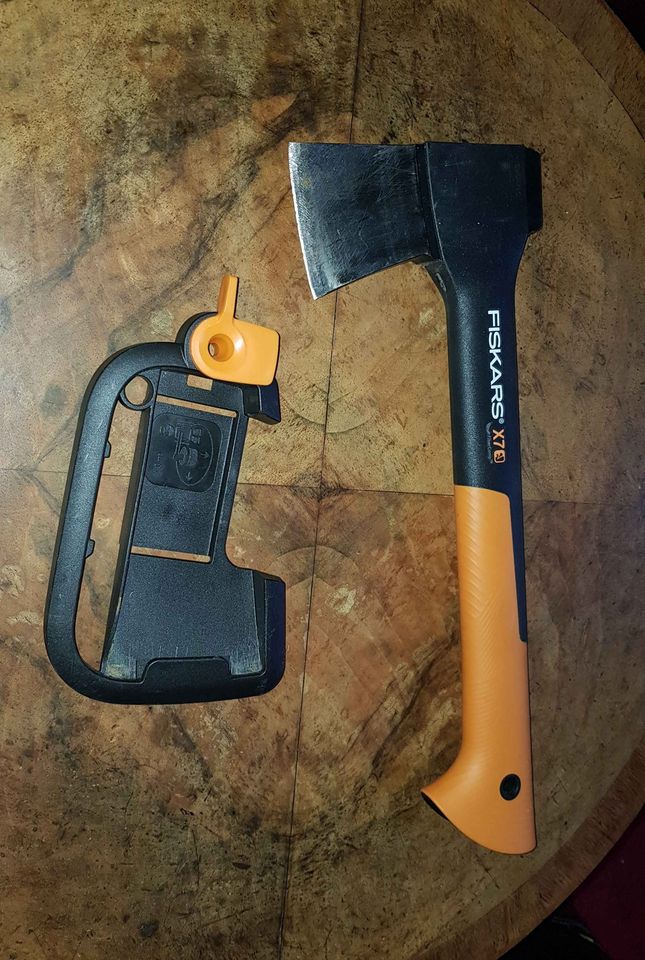
I really like the design of this axe. Instead of the handle going up to the bottom of the head, it goes all the way to the top of the tool and the axe head is actually moulded into it. This gives it a sense and feeling of superior robustness, and certainly wasn’t shy about putting through its paces.
You don’t have to worry about having to sharpen the blade with this axe either. You can use it as soon as it arrives and it’ll cut through anything within 7cm diameter with ease. What’s more, the blade edge stays sharp for an impressive length of time.
Plastic guards/sheaths are not really my thing, and I prefer a traditional leather one, but the one that comes with this Fiskers axe has been well designed. It clips on easily and securely, and will stop you cutting yourself. However, I have found that this type of guard does dull axes’ blades over time.
Pros
- Trusted brand with a great record
- Excellent quality throughout
- Extremely durable and reliable
- Fibreglass handle is lightweight but very solid and robust
Cons
- The higher price might put some people off if they aren’t planning to use their axe too often.
3. LEXIVON V14 Camping Hatchet
The best way I can describe the Lexivon V14 camping hatchet is that it is basically a cheaper clone of the excellent Fiskars XS X7. Can it compete with its better-known competition? Well, let’s take a closer look at it-
First of all, the Lexivon V14’s design is almost identical, right down to the head being moulded into the handle, and the flared handle base. So, at first glance it seems you’re getting the same product for less money, but there are differences in the way the two tools feel.
For example, the fibre glass handle is hollow on the Lexivon and doesn’t feel as solid as the Fiskars XS X7. Now, I wouldn’t say it is flimsy or anything like that, it’s just not up to the same quality and you feel more vibrations, but I guess that’s why it’s much cheaper. On the plus side, it does feel very lightweight, so good for camping and backpacking.
The metal used for the axe head is advertised as being grade A carbon steel, but I have my doubts there. I’m not an expert on metals, but I’ve been around tools long enough to know when something is made of high-quality carbon steel and I don’t think this is.
Again though, there’s nothing wrong with the blade apart from that it needed sharpening, and it performed really well when splitting small logs for kindling, I just think the advertising should have been more accurate. If it had, I maybe wouldn’t have been as harsh with my review.
At the end of the day, it’s a good camping hatchet for the money. It falls a little short when compared to the more expensive Fiskars axe, but that’s to be expected, and shouldn’t really put you off unless you’re willing to pay the extra for the better products. It’s lightweight and compact design would make it a good, low-cost, backpacker’s tool.
Pros
- Very lightweight and compact design is good for backpackers
- Inexpensive clone of hatchets like Fiskars and Davaon and features many of the same design aspects
- Good choice for splitting small logs
- Performed well once sharpened properly
Cons
- Hollow handle doesn’t feel as robust as more expensive hatchets and axes
4. Draper 62166 Steel Shafted Hand Axe
Although fibre glass handles are all the rage these days, and as robust as they can be, there are still plenty of traditionalists out there who prefer a solid metal shafted hand axe like this one from Draper tools. Before I get going – here’s a reasonable overview:
Personally, I’ve always found that metal handles on axes and hammers don’t do enough to reduce vibration, so it’s good to see that Draper has addressed this with a nice, thick rubber grip. Not only does it do a bang-up job of taking care of vibrations, the rubber keeps the axe from slipping your clasp really well too.
There’s a natural feeling when this axe is in your hand, and I think that’s largely due to the ergonomic handle having a slight curve to it, and the weight distribution of the tool being well-balanced.
I will say that it does feel a bit heavy after using it for a while, and the blade was pretty dull when the tool arrived, but these are minor complaints. I really didn’t like the quality of the plastic blade cover, and expected more from draper, but again, a small gripe.
At the end of the day, this is a short-handled axe that is good for splitting smaller-sized logs into kindling, and is compact enough to be thrown in a backpack for a camping trip. It feels very solid, as it should be being made mostly out of steel, and at less than 15 quid (at the time I wrote this) it’s not going to empty your bank account.
Pros
- Metal construction and very robust
- Rubber cover on handle helps with grip and vibration
- Feels very natural in the hand
- The heavy head gives you good momentum in your strikes
Cons
- The plastic blade cover could be better quality
5. Ruthe VPA/GS Hatchet
So far, the majority of the axes and hatchets we’ve featured have been smaller tools that are fine for chopping logs around 10cm-15cm diameter, but for tackling larger chunks of wood, you need something a bit bigger.
Now, you could go all the way up to a two-hand axe, or you could get something like this stunning hickory handled hatchet from Ruthe, which gives you a bit more length and weight than a compact camping hatchet, but can still be wielded in one hand.
The extra weight offered by Ruthe’s VPA/GS hatchet does make splitting logs for kindling noticeably easier, and you will get through them with less strikes. However, that is only after you spend some time sorting the blade out as it arrives quite blunt, and in our case, slightly bent.
If you are prepared to take the time to sharpen the blade, you will be rewarded with a durable tool that, thanks to its lovely hickory handle, looks as good as it cuts. As wood is a natural vibration absorber, it feels good to use too, and the smooth finish makes sure that you won’t be pulling splinters out of your hands every five minutes.
Forged and hardened steel has been used for the head, and once sharpened it cuts well. I found that the blade kept its edge fairly well, and the weight balance was never an issue. There were one or two small quality control issues concerning the edge of the blade on arrival, but if you have the skill and time to set right, you can get yourself a beautiful, working hatchet for a very good price.
Pros
- A good axe for splitting logs larger than 10cm in diameter
- Beautiful traditional look
- Hickory handle absorbs vibrations well
- Blade keeps its edge after you spend some time sorting it out
Cons
- If you don’t like sharpening and shaping your axe’s edge, this isn’t the tool for you.
Here’s a video for all you DIY nuts out there who might fancy making a replacement hickory handle for their Ruthe hatchet-
6. Davaon Pro 46cm Log Splitting Axe
The Davaon Pro log splitting axe is another example of having to pay a little bit more to get the really top-quality tools, and is an excellent choice for people looking for a kindling axe for frequent use.
As soon as you hold the Davaon Pro, a few things spring instantly to mind. First, is that this a hand axe and not a hatchet, seen and felt clearly with the larger and heavier head, and secondly, that they haven’t scrimped on quality.
You can tell that the axe head has been made with top-notch carbon steel, and that means it will sharpen and hold a nice edge better than with inferior materials. For you, it equates to less effort needed to split the logs and get the kindling you’re after.
Just like with the Fiskars axe we reviewed earlier in this article, weight distribution and balance on this tool is excellent, and you get a great combination of momentum in your downward swing matched with accuracy and stability.
At 46cm long, this isn’t exactly a compact tool that you can take backpacking with you, but the extra length adds even more power to your swing, and thus makes it possible to chop logs that are up to 20cm in diameter with ease.
As I’ve said, I’m not a lover of these plastic edge guards, particularly with cheaper axes and hatchets as they are usually poor quality and sometimes outright dangerous. But I have to say that the one that comes with the Davaon Pro is made from robust plastic, and this design does make it easy to hang the tool up when not in use.
Pros
- Top-notch quality from top to tail
- Larger and heavier than a a hatchet and will split logs up to 20cm in diameter
- Excellent balance and weight distribution
- High quality carbon steel head
Cons
- Not a tool you can carry in a backpack or take camping easily.
History of axes and hatchets – a final say
Since prehistoric times, man has used axes in one way or another to shape our path all the way to the present. The first axes, were nothing more than sharpened stones, such as flint, with no handles, but usually having shaped areas for the fingers to grip them. It wasn’t until around 6000BC that we started seeing the creation of axes as we know them today, with a ‘haft’ better known as a handle. Axe handles have nearly always been made of some kind of hardwood and still today, many axes still have a wooden haft, but with advances in material technologies, it is common to see handles constructed from synthetic materials like polypropylene, so as to keep the axe as light as possible. Whilst they don’t pack the same punch as a chainsaw or they won’t turn logs into firewood like a log splitter, but they are useful for smaller applications such as kindling.
That last review brings to an end this page of reviews for the best axes and hatches. Hopefully, you now feel a little more well informed on the best value axes out there on the UK market. Of course, there are higher quality, professional products out there for very high prices but we chose these axes and hatchets because we feel they are the best available in a price range that is affordable for most people out there.


















